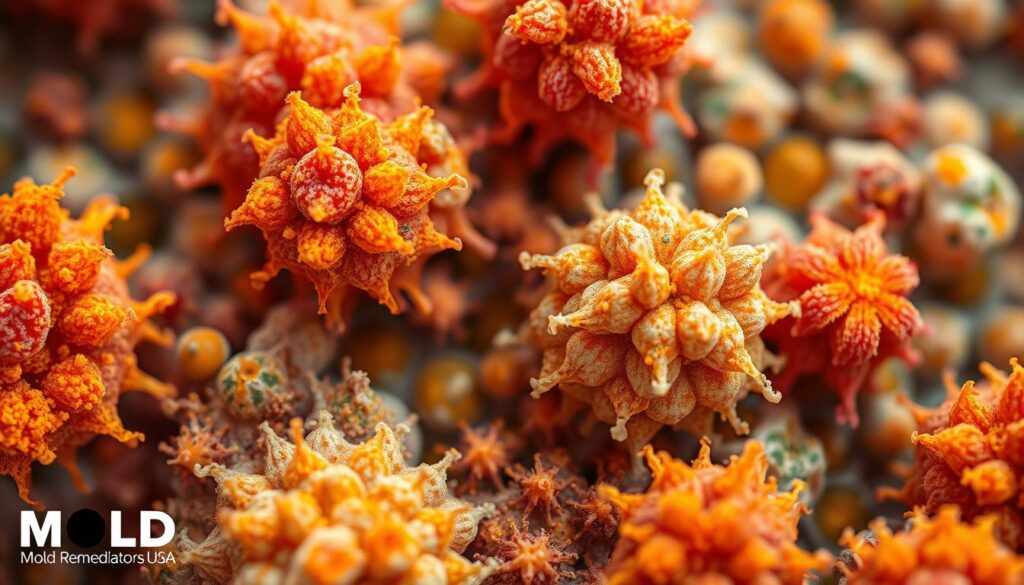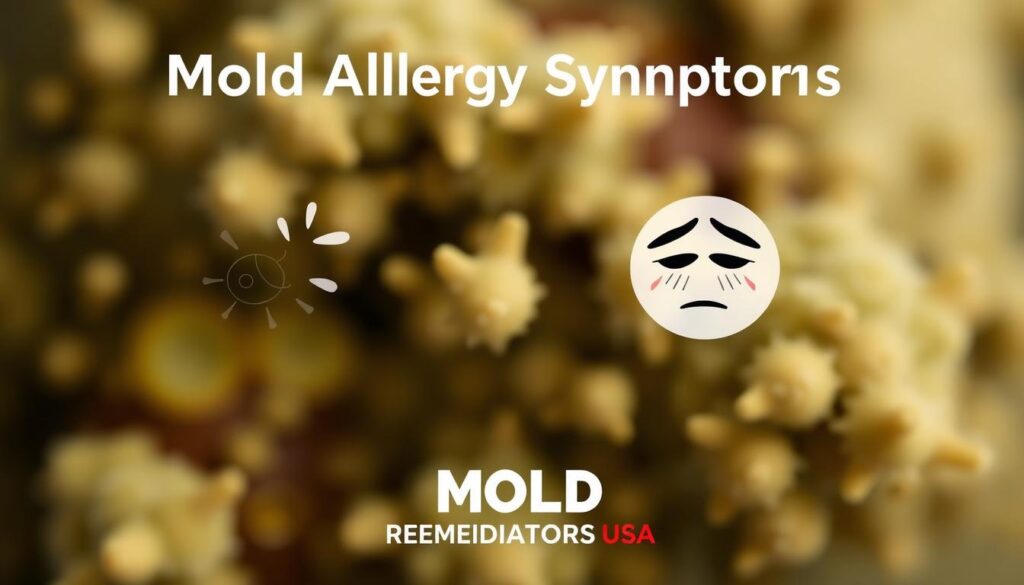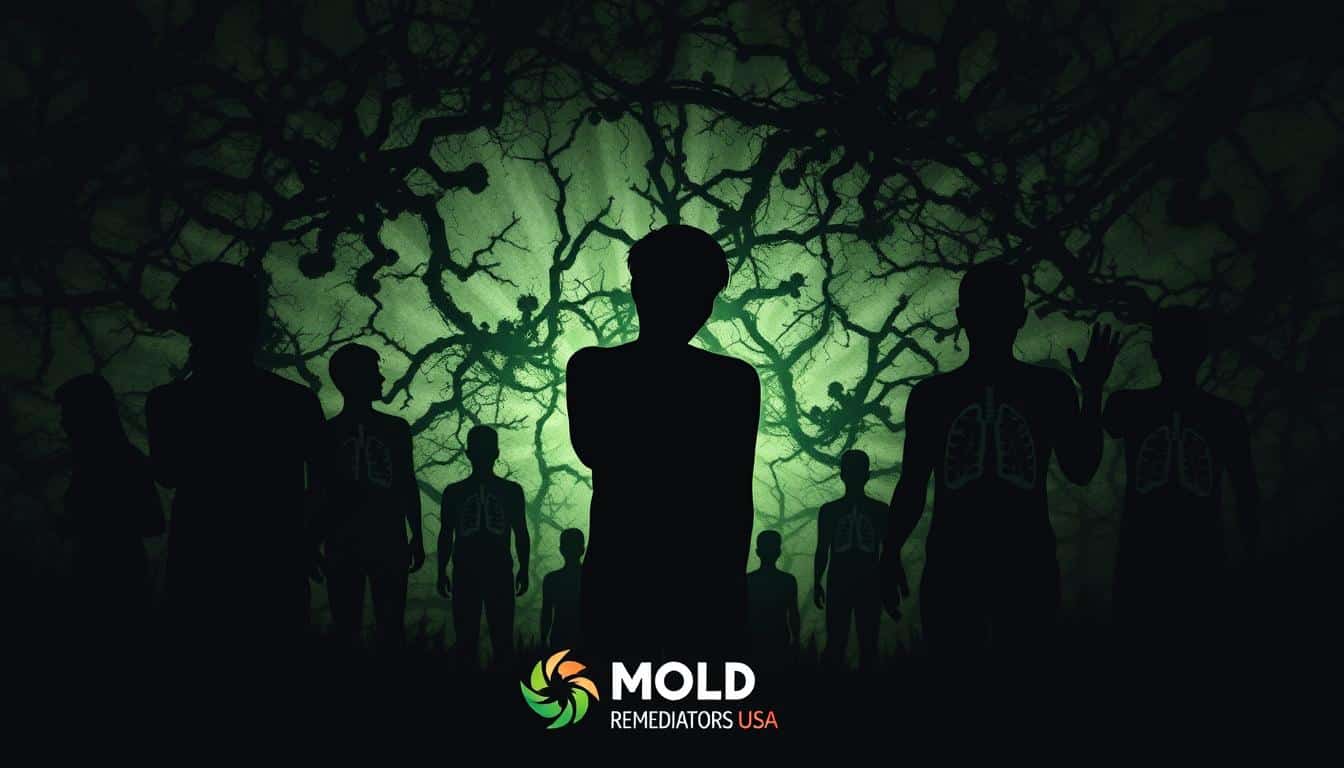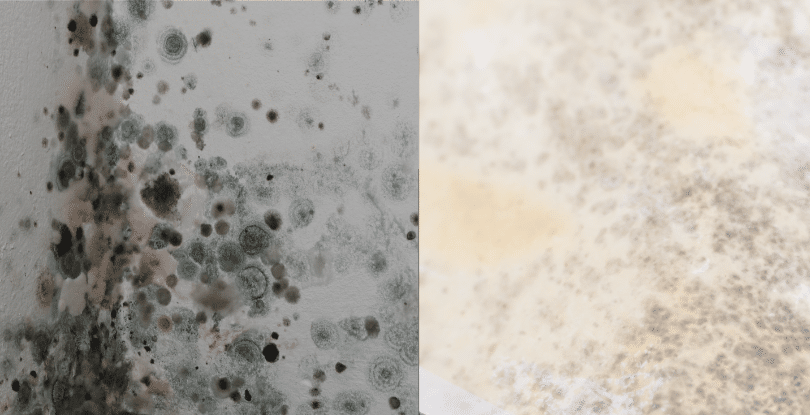Did you know up to 24% of people may have mold allergies1? This fact shows how common mold’s impact on our health is. Exploring mold toxicity symptoms reveals a hidden threat affecting many without their knowledge.
Mold illness is more than a musty smell. It’s a serious health issue causing respiratory and cognitive problems. What’s scary is mold can grow in just 24 hours after water damage1. This quick growth means we might not even notice we’re exposed to toxic mold.
The effects of mold exposure can last a long time. Symptoms can last from days to years, depending on the person1. It’s vital to know the signs of mold toxicity and act fast.
What’s worrying is doctors might mistake mold symptoms for other conditions. This includes depression, anxiety, chronic fatigue, or even Lyme disease1. This mistake can cause delayed treatment and more suffering for those with mold illness.
When we look at mold toxicity symptoms, it’s key to remember both toxic and nontoxic mold can harm us. Research shows exposure to either can affect our brain and lead to cognitive and emotional problems2. This highlights the importance of being aware and acting quickly when dealing with mold.
Key Takeaways
- Mold allergies affect a significant portion of the population
- Mold growth can occur rapidly after water damage
- Symptoms of mold exposure can vary in duration and severity
- Mold-related health issues are often misdiagnosed
- Both toxic and nontoxic mold can cause health problems
- Understanding mold toxicity symptoms is crucial for early detection and treatment
Understanding Mold and Its Prevalence
Mold is a common problem in homes and buildings across the United States. On average, there are about 14 instances of mold per building. This shows how widespread the issue is3. In Europe, mold affects 1 in 6 homes, making it a global concern3.
What is mold and where does it grow?
Mold is a type of fungi that thrives in moist environments. It breaks down organic matter and can grow on various surfaces like wood, paper, and drywall. Homes near water bodies or in coastal areas often experience more mold growth due to higher humidity levels4.
Common sources of moisture in homes
Moisture is the key factor in mold growth. Common moisture sources include:
- Roof leaks
- Plumbing issues
- Poor ventilation
- High humidity levels
Buildings with over 50% humidity are breeding grounds for mold. People living or working in such environments are more likely to develop mold allergies and experience symptoms3.
Identifying mold problems in your living space
Identifying mold involves visual inspection and recognizing musty odors. The EPA warns that indoor air quality is often worse than outdoor air due to mold presence4. Look out for these common mold allergy symptoms:
| Respiratory | Skin | Eye |
|---|---|---|
| Sneezing | Dry, scaly skin | Itchy eyes |
| Runny or stuffy nose | Skin irritation | Watery eyes |
| Cough and postnasal drip | Rashes | Red eyes |
If you notice these symptoms or suspect mold, it’s crucial to address the issue promptly. Regular cleaning, moisture control, and improving ventilation are key steps in preventing mold growth and maintaining a healthy living environment5.
The Science Behind Mold Toxicity
Mold toxicity is a complex issue that affects many people. About 25% of individuals report symptoms from mold exposure each year6. This problem impacts homeowners, renters, and employees in mold-prone environments. The science behind mold toxicity involves exposure to mold spores and mycotoxins, toxic compounds produced by certain mold species6.
Mold thrives in damp, humid environments like basements, bathrooms, and areas near water sources6. To prevent mold growth, it’s crucial to maintain indoor humidity levels below 50%7. The World Health Organization estimates that 10% to 50% of indoor environments in developed countries have significant mold problems8.

The effects of fungal toxicity can vary widely. People with allergies or weakened immune systems are often more sensitive to mold7. Exposure can lead to various health issues, primarily affecting the respiratory system. A meta-analysis found a 30% to 50% increase in asthma and related problems due to dampness or mold exposure8.
Interestingly, mold exposure doesn’t just increase the risk of fungal allergies. It can also make you more susceptible to other allergens like dust mites and pollen8. This occurs through epigenetic changes that boost inflammatory gene expression.
While the health impacts of mold toxicity remain somewhat controversial in scientific circles, the evidence for its effects on respiratory health is substantial68. As research continues, our understanding of mold toxicity and its wide-ranging impacts on human health continues to grow.
Types of Mold and Their Health Impacts
Mold is a common problem in many homes. It’s important to know about its different types and health effects. I’ll share facts about black mold, other toxic mold species, and how mycotoxins affect our health.
Black mold: Facts and misconceptions
Black mold, often called Stachybotrys chartarum, is known for being toxic. But, it’s not always more dangerous than other molds. Being exposed to a lot of mold spores can make some people sick9.
Other common toxic mold species
There are other toxic molds that can harm us too. These include:
- Aspergillus
- Penicillium
- Fusarium
Mold spores are always in the air we breathe. But, too much mold can make us sick10. Mold can look fuzzy, discolored, or slimy and grow bigger if not treated10.
Mycotoxins and their effects on human health
Some molds, like Stachybotrys and Aspergillus, make toxins called mycotoxins. This can cause serious health problems9. People at risk include babies, the elderly, those with weak immune systems, and those with breathing problems9.
Mold exposure symptoms may include nasal and sinus congestion, eye irritation, wheezing, cough, throat irritation, skin irritation, and headache.
It’s important to know that serious mold infections are rare. They mostly happen in people with very weak immune systems10. If you think you have mold at home, fix it fast to keep yourself and your family healthy.
| Mold Type | Appearance | Common Locations | Potential Health Effects |
|---|---|---|---|
| Stachybotrys chartarum (Black Mold) | Dark green or black, slimy | Damp areas, water-damaged materials | Respiratory issues, allergic reactions |
| Aspergillus | Various colors, powdery | Air conditioning systems, foods | Lung infections, allergic reactions |
| Penicillium | Blue-green, velvety | Damp building materials, spoiled foods | Allergies, asthma attacks |
| Fusarium | Pink, white, or purple | Soil, plants, humidifiers | Eye infections, skin lesions |
What Are the Symptoms of Mold Toxicity?
Mold toxicity happens when you’re exposed to a lot of mold spores and mycotoxins over time11. This can cause many health problems. Let’s look at the main symptoms you should watch for.
Respiratory Symptoms
Breathing issues are often the first sign of mold exposure. You might have a persistent cough, wheezing, or sinus congestion11. If you have allergies or asthma, mold can make your symptoms worse11.
About half of U.S. homes have water damage and mold growth. This increases the risk of mold-related health issues12.
Neurological Symptoms
Mold toxicity can affect your brain. You might have frequent headaches, light sensitivity, or trouble concentrating11. Some people experience memory problems or brain fog1112.
These signs of mold exposure can be mistaken for other conditions. This makes diagnosis tricky.
Skin-related Symptoms
Your skin can react to mold too. Watch for red, watery, or itchy eyes11. Skin irritation is another common mold allergy symptom13.
If you notice unexplained rashes or itching, mold could be the culprit.
Digestive and Systemic Symptoms
Mold toxicity can affect your whole body. You might feel unusually tired or weak11. Mold can suppress your immune system, leading to frequent infections or slow healing11.
Some people experience nausea or joint pain. These systemic symptoms can vary from person to person13.

| Symptom Category | Common Symptoms |
|---|---|
| Respiratory | Coughing, wheezing, sinus congestion |
| Neurological | Headaches, brain fog, memory issues |
| Skin-related | Rashes, itchy eyes, skin irritation |
| Digestive/Systemic | Fatigue, nausea, joint pain |
Remember, mold symptoms can mimic other conditions. If you suspect mold exposure, it’s important to consult a healthcare professional. They can run tests like skin tests or mold antibody tests to confirm mold-related health issues13.
Risk Factors for Mold Sensitivity
Mold sensitivity can affect anyone, but some factors increase our risk. A weakened immune system is key in how we react to mold. People with asthma or other respiratory issues are more at risk. Our genes also play a part in how our body handles mold toxins.
Environmental factors greatly affect mold sensitivity. Living in humid areas or water-damaged buildings raises our exposure risk. Mold grows well in damp places, spreading through tiny spores that can easily get into our homes14.
Here’s a list of common risk factors for mold sensitivity:
- Compromised immune system
- Asthma or other respiratory conditions
- Genetic factors
- Living in high-humidity areas
- Residing in water-damaged buildings
Mold exposure can cause many symptoms. These include breathing problems, fatigue, joint pain, headaches, and trouble focusing1415. Long-term exposure can lead to serious health issues, affecting our overall health.
Knowing these risk factors helps us protect our health. We can reduce our risk by addressing environmental issues and keeping our immune system strong. If you think you might have mold sensitivity, see a healthcare professional for help.
Diagnosing Mold Toxicity: Challenges and Methods
Finding out if someone has mold toxicity can be hard. Symptoms often look like other health issues, leading to wrong diagnoses. Let’s look at why this happens and how tests help diagnose mold toxicity.
Why Mold Toxicity is Often Misdiagnosed
Mold toxicity symptoms can be very broad. They include breathing problems, brain fog, and physical pain like stomach issues16. These signs can match many other illnesses, making it tough for doctors to say it’s mold.
Testing Methods for Mold Exposure
There are several ways to find out if someone has been exposed to mold:
- Urine tests for mold metabolites
- Blood tests for mold antibodies
- Environmental testing for mold presence16
Skin prick tests can also show if someone is sensitive to mold. If it’s positive, a bump will show up on the skin17.
The Role of Healthcare Professionals in Diagnosis
Doctors and healthcare workers are very important in figuring out mold toxicity. They look at the patient’s history and do special tests. A study showed that 41% of people exposed to mold had higher IgE levels than those not exposed18. This shows how important it is to have a doctor’s help in testing for mold.
| Test Type | Purpose | Effectiveness |
|---|---|---|
| Skin Prick Test | Detect mold sensitivity | Quick results, but becoming rare |
| Blood Test | Measure mold antibodies | Increasingly common alternative |
| Environmental Testing | Identify mold presence | Crucial for confirming exposure |
To accurately diagnose mold toxicity, we need a mix of these tests and expert advice. Environmental testing is especially important for proving exposure and planning treatment.
Preventing Mold Growth in Your Home
Mold prevention is key to a healthy home. It’s all about controlling moisture and keeping up with home maintenance. Let’s explore some effective ways to protect your home.
First, keeping humidity indoors below 50% is crucial to stop mold19. Use dehumidifiers and air conditioners to lower air moisture, especially in humid areas20. In wet rooms like bathrooms and kitchens, installing fans is essential for controlling moisture20.
Act fast when dealing with water damage. Dry out flooded areas within 48 hours to avoid black mold21. Any wet spot in your home should be dried in 24 to 48 hours to prevent mold20.
Regular home upkeep is vital for mold prevention. Here are some important tasks:
- Fix leaks and seepage quickly20
- Clean air conditioning drip pans often20
- Make sure basements and crawl spaces are well-ventilated and dry20
- Vent clothes dryers outside20
For extra protection, add mold inhibitors to paints before use19. Coastal homes face a higher risk of mold due to humidity and moisture21.
Prevention is better than cure for mold. By following these moisture control and maintenance tips, you’ll make your home healthier for your family.
| Area | Prevention Strategy | Importance |
|---|---|---|
| Whole House | Keep humidity below 50% | High |
| Bathrooms/Kitchens | Install ventilation fans | High |
| Flooded Areas | Dry within 48 hours | Critical |
| Basements/Crawl Spaces | Ensure good ventilation | Medium |
| Laundry Room | Vent dryer to outside | Medium |
Treatment Approaches for Mold Toxicity
Dealing with mold toxicity requires a multi-faceted approach. We aim to tackle both symptoms and causes. Here are some effective strategies for recovery.
Conventional Medical Treatments
Doctors often start with managing symptoms. This might include antihistamines for allergies or antifungal meds for mold. In serious cases, allergy shots can boost your immunity22.
If you have ongoing symptoms like sniffles or trouble concentrating, see a lung specialist. These signs could point to mold toxicity22.
Alternative and Holistic Approaches
Many find relief in holistic detox methods. Using binders like activated charcoal can help remove toxins23. Infrared saunas and detox baths also aid in natural detox23.
For emotional or cognitive issues, experts suggest limbic system training. This includes meditation and neuroplasticity exercises23. Learn more at mold remediation services.
Environmental Remediation Strategies
Treating mold toxicity means making your environment healthy. This involves mold inspection and removal. Fixing moisture issues is key to prevent mold return.
About 25% of people are mold sensitive. For them, avoiding moldy environments is crucial for recovery23. Combining medical treatments, detox, and environmental fixes can help you overcome mold toxicity and regain health.
FAQ
What are the symptoms of mold toxicity?
Symptoms of mold toxicity include breathing problems like coughing and wheezing. You might also have sinus issues. Other signs are skin rashes and digestive problems like nausea and fatigue.
What is mold and where does it grow?
Molds are fungi that break down organic matter. They grow in moist places. You can find them on wood, paper, and drywall in homes and workplaces.
What are mycotoxins and their effects?
Mycotoxins are toxic compounds from mold. They can cause inflammation in the body. This can lead to health problems when people are exposed.
Is black mold more dangerous than other mold types?
Black mold, like Stachybotrys chartarum, isn’t always more dangerous. Different mold types can produce mycotoxins. These can affect human health.
What are some common toxic mold species?
Toxic mold species include Aspergillus, Penicillium, and Fusarium. They can produce mycotoxins. These can cause respiratory, neurological, and other health issues.
What are some risk factors for mold sensitivity?
Being more sensitive to mold can depend on several factors. A weakened immune system and pre-existing respiratory conditions are risks. Genetic predisposition and living in humid climates also play a part.
Why is mold toxicity often misdiagnosed?
Mold toxicity is hard to diagnose because its symptoms are wide-ranging. They can be similar to other conditions. This makes it tricky to pinpoint.
How can I prevent mold growth in my home?
To prevent mold, control moisture levels. Fix leaks quickly and improve ventilation. Use dehumidifiers in damp areas. Regular home maintenance is also key.
What are some treatment approaches for mold toxicity?
Treating mold toxicity involves several steps. Medical treatments include antifungal medications and managing symptoms. Alternative methods include detoxification and immune support. Environmental remediation is also crucial.
Source Links
- How Do You Know If Mold Is Making You Sick? – EnviroMed Clinic – https://enviromedclinic.com/how-do-you-know-if-mold-is-making-you-sick/
- Mold inhalation causes innate immune activation, neural, cognitive and emotional dysfunction – https://www.ncbi.nlm.nih.gov/pmc/articles/PMC7231651/
- Can Mold Make You Sick? Signs of Mold Exposure – https://www.healthline.com/health/mold-in-house
- The Neurological Effects of Mold: The Hidden Threat – https://www.gpinspect.com/article/neurological-symptoms-of-mold-exposure/
- Mold allergy-Mold allergy – Symptoms & causes – Mayo Clinic – https://www.mayoclinic.org/diseases-conditions/mold-allergy/symptoms-causes/syc-20351519
- 12 Mold Toxicity Symptoms You Shouldn’t Ignore – https://www.parsleyhealth.com/blog/mold-toxicity-symptoms/
- Black mold exposure: Symptoms, treatment, and prevention – https://www.medicalnewstoday.com/articles/323419
- Is Mold Toxicity Really a Problem for Our Patients? Part I—Respiratory Conditions – https://www.ncbi.nlm.nih.gov/pmc/articles/PMC4898283/
- Mold Health Risks: Department of Health – https://health.ri.gov/healthrisks/mold/
- What You Need to Know – https://www.health.ny.gov/publications/7287/
- 10 Warning Signs Of Mold Toxicity You Shouldn’t Ignore – https://atticprosinc.com/10-warning-signs-of-mold-toxicity-you-shouldnt-ignore/
- Symptoms of Mold Exposure – Dr. Todd Maderis – https://drtoddmaderis.com/symptoms-of-mold-exposure
- The Top 11 Symptoms of Mold Exposure & Toxic Mold Syndrome – https://puremaintenancenebraska.com/symptoms-of-mold-exposure/
- Can Black Mold Kill You? – https://www.webmd.com/lung/can-black-mold-kill-you
- 8 Signs Of Mold Toxicity and Its Impact on Your Thyroid | Paloma Health – https://www.palomahealth.com/learn/8-warning-signs-mold-toxicity-thyroid?srsltid=AfmBOorSXMBVZXaJVz3iUeBsAeodebclNF7EXAqYjUrjzDmf1LP728MF
- Mold Toxicity Symptoms – Diagnosis And Recovery Strategies – https://www.moldguy.ca/mold-toxicity/
- Mold allergy-Mold allergy – Diagnosis & treatment – Mayo Clinic – https://www.mayoclinic.org/diseases-conditions/mold-allergy/diagnosis-treatment/drc-20351525
- What should be tested in patients with suspected mold exposure? Usefulness of serological markers for the diagnosis – https://www.ncbi.nlm.nih.gov/pmc/articles/PMC8982061/
- Mold – https://www.cdc.gov/mold-health/about/index.html
- Moisture and Mold Problems: Preventing and Solving Them in Your Home – https://www.webmd.com/lung/mold-mildew
- Black Mold In Your Home? Causes, Symptoms, Prevention – https://www.gpinspect.com/article/black-mold-exposure-symptoms/
- Mold Toxicity Testing and Treatment | Lung & Sleep Specialists of North Texas – https://lungandsleepspecialists.com/mold-toxicity-testing-and-treatment/
- Mold Toxicity Symptoms & Treatment – https://boulderholistic.com/mold-toxicity-symptoms-treatment/




